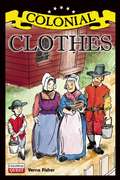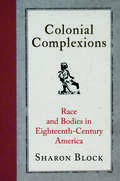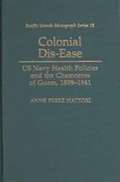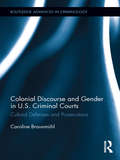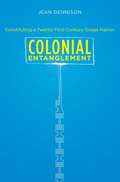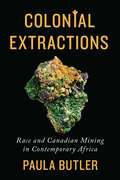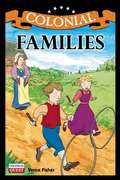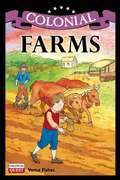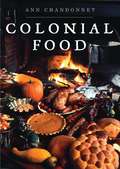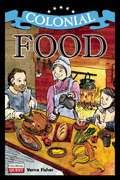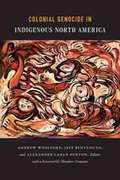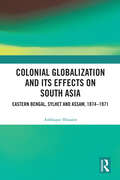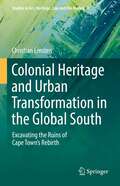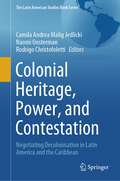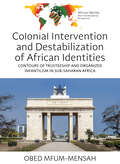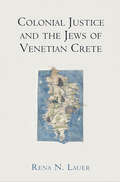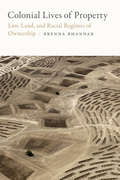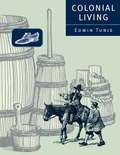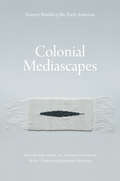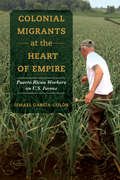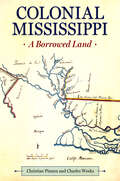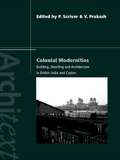- Table View
- List View
Colonial Clothes
by Verna FisherLooking at the clothing that men and women wore in colonial times, this book examines how fabrics were made and discusses the work of various professions related to clothing, including tailors, cobblers, tanners, milliners, and wigmakers.
Colonial Clothes (Colonial Quest)
by Verna FisherTaking young readers on a journey back in time, this dynamic new series showcases various aspects of colonial life, from people and clothing to homes and food. Each book contains creative illustrations, interesting facts, highlighted vocabulary words, end-of-book challenges, and sidebars that help children understand the differences between modern and colonial life and inspire them to imagine what it would have been like to grow up in colonial America. The volumes in this series focus on the colonists but also include relevant information about Native Americans, offering a variety of perspectives on life in the colonies. Looking at the clothing that men and women wore in colonial times, this book examines how fabrics were made and discusses the work of various professions related to clothing, including tailors, cobblers, tanners, milliners, and wigmakers.
Colonial Complexions: Race and Bodies in Eighteenth-Century America (Early American Studies)
by Sharon BlockIn Colonial Complexions, historian Sharon Block examines how Anglo-Americans built racial ideologies out of descriptions of physical appearance. By analyzing more than 4,000 advertisements for fugitive servants and slaves in colonial newspapers alongside scores of transatlantic sources, she reveals how colonists transformed observable characteristics into racist reality. Building on her expertise in digital humanities, Block repurposes these well-known historical sources to newly highlight how daily language called race and identity into being before the rise of scientific racism.In the eighteenth century, a multitude of characteristics beyond skin color factored into racial assumptions, and complexion did not have a stable or singular meaning. Colonists justified a race-based slave labor system not by opposing black and white but by accumulating differences in the bodies they described: racism was made real by marking variation from a norm on some bodies, and variation as the norm on others. Such subtle systemizations of racism naturalized enslavement into bodily description, erased Native American heritage, and privileged life history as a crucial marker of free status only for people of European-based identities.Colonial Complexions suggests alternative possibilities to modern formulations of racial identities and offers a precise historical analysis of the beliefs behind evolving notions of race-based differences in North American history.
Colonial Dis-ease: US Navy Health Policies and the Chamorros of Guam, 1898-1941
by Anne Perez HattoriExamines U.S. military colonialism through the lens of Western medicine and its cultural impact.
Colonial Discourse and Gender in U.S. Criminal Courts: Cultural Defenses and Prosecutions (Routledge Advances in Criminology)
by Caroline BraunmühlThe occurrence in some criminal cases of "cultural defenses" on behalf of "minority" defendants has stirred much debate. This book is the first to illuminate how "cultural evidence" — i.e., "evidence" regarding ethnicity — is actually negotiated by attorneys, expert/lay witnesses, and defendants in criminal trials. Caroline Braunmühl demonstrates that this has occurred, overwhelmingly, in ways shaped by colonialist and patriarchal discourses common in the Western world. She argues that the controversy regarding the legitimacy of a "cultural defense" has tended to obscure this fact, and has been biased against minorities as well as all women from its inception, in the very terms in which the question for debate has been framed. This study also breaks new ground by analyzing the strategies, and the failures, in which colonialist and patriarchal constructions of cultural evidence are resisted or — more commonly — colluded in by opposing attorneys, witnesses, and defendants themselves. The constructions at hand emerge as contradictory and unstable, belying the notion that cultural evidence is a matter of objective "information" about another culture, rather than — as Braunmühl argues — of discourses that are inevitably normatively charged. Colonial Discourse and Gender in US Criminal Courts moves the debate about cultural defenses onto an entirely new plane, one based upon the understanding that only in-depth empirical analyses informed by critical, rigorous theoretical reflection can do justice to the irreducibly political character of any discussion of "cultural evidence," and of its presentation in court.
Colonial Entanglement
by Jean DennisonFrom 2004 to 2006 the Osage Nation conducted a contentious governmental reform process in which sharply differing visions arose over the new government's goals, the Nation's own history, and what it means to be Osage. The primary debates were focused on biology, culture, natural resources, and sovereignty. Osage anthropologist Jean Dennison documents the reform process in order to reveal the lasting effects of colonialism and to illuminate the possibilities for indigenous sovereignty. In doing so, she brings to light the many complexities of defining indigenous citizenship and governance in the twenty-first century. By situating the 2004-6 Osage Nation reform process within its historical and current contexts, Dennison illustrates how the Osage have creatively responded to continuing assaults on their nationhood. A fascinating account of a nation in the midst of its own remaking, Colonial Entanglement presents a sharp analysis of how legacies of European invasion and settlement in North America continue to affect indigenous people's views of selfhood and nationhood.
Colonial Extractions
by Paula ButlerChallenging Canada's image as a humane, enlightened global actor, Colonial Extractions examines the troubling racial logic that underpins Canadian mining operations in several African countries. Drawing on colonial, postcolonial, and critical race theory, Paula Butler investigates Canadian mining activities and the discourses which serve to legitimate this work.Through a series of interviews with senior personnel of businesses with mining operations in Africa, Butler identifies a continuation of the same colonialist mindset that saw resource ownership and racial dominance over Indigenous peoples in Canada as part of Canada's nation-building project. Financially, culturally, and psychologically, Canadians are invested in extracting resource-based wealth in the Global South, and - as Butler's analysis of Canada's influence over South Africa's first post-apartheid mining legislation shows - they look to legitimize that extraction through neoliberal legal frameworks and a powerful national myth of benevolence.Complementing analyses of the industry through political economy or critical development studies, Colonial Extractions is a powerful and unsettling critique of the cultural dimension of Canada's mining industry overseas.
Colonial Families
by Verna FisherWhat was family life like in Colonial America? Did family life vary from one area of the country to another? How did life in a colonial family compare to that of the Native Americans of the time? Did colonial children go to school? Find out the answers to these questions and more.
Colonial Farms
by Verna FisherWhat kinds of food were grown on colonial farms? Did the colonists have farm animals? Why did farm life vary from one area of the country to another? How did colonial farms compare to farms of the Native Americans? Find out the answers to these questions and more.
Colonial Food
by Ann ChandonnetOf the one hundred Pilgrims who settled at Plymouth in 1620, nearly half had died within months of hardship, starvation or disease. One of the colony's most urgent challenges was to find ways to grow and prepare food in the harsh, unfamiliar climate of the New World. From the meager subsistence of the earliest days and the crucial help provided by Native Americans, to the first Thanksgiving celebrations and the increasingly sophisticated fare served in inns and taverns, this book provides a window onto daily life in Colonial America. It shows how European methods and cuisine were adapted to include native agriculture such as maize, potatoes, beans, peanuts and tomatoes, and features a section of authentic menus and recipes, including apple tansey and crab soup, which can be used to prepare your own colonial meals.
Colonial Food
by Verna FisherFood discusses how the colonists obtained, prepared, and ate their food. It looks at the new foods they discovered when they came to America, the difficulties they initially experienced in producing enough food to survive, the help they received from friendly Native Americans in growing crops, and geographic variations in their diet, from apples in the North to sweet potatoes in the South. The book also covers how the colonists cooked their food and the utensils that they used to eat it. Finally, it talks about how Native Americans lived off the land, hunting, trapping, and growing squash, corn, and beans with the Three Sisters method.
Colonial Genocide in Indigenous North America
by Alexander Laban Hinton Andrew Woolford Jeff BenvenutoThis important collection of essays expands the geographic, demographic, and analytic scope of the term genocide to encompass the effects of colonialism and settler colonialism in North America. Colonists made multiple and interconnected attempts to destroy Indigenous peoples as groups. The contributors examine these efforts through the lens of genocide. Considering some of the most destructive aspects of the colonization and subsequent settlement of North America, several essays address Indigenous boarding school systems imposed by both the Canadian and U.S. governments in attempts to "civilize" or "assimilate" Indigenous children. Contributors examine some of the most egregious assaults on Indigenous peoples and the natural environment, including massacres, land appropriation, the spread of disease, the near-extinction of the buffalo, and forced political restructuring of Indigenous communities. Assessing the record of these appalling events, the contributors maintain that North Americans must reckon with colonial and settler colonial attempts to annihilate Indigenous peoples.Contributors. Jeff Benvenuto, Robbie Ethridge, Theodore Fontaine, Joseph P. Gone, Alexander Laban Hinton, Tasha Hubbard, Margaret D. Jabobs, Kiera L. Ladner, Tricia E. Logan, David B. MacDonald, Benjamin Madley, Jeremy Patzer, Julia Peristerakis, Christopher Powell, Colin Samson, Gray H. Whaley, Andrew Woolford
Colonial Globalization and its Effects on South Asia: Eastern Bengal, Sylhet, and Assam, 1874–1971
by Ashfaque HossainThis book investigates the concept of colonial globalization to show how knowledge, information, technology, capital, and labour have the potential to move freely across the world. It studies the experience of globalization ‘from below’, rather than from the perspective of the British imperial centre. Focusing on the impact of colonial globalization on the people of Sylhet, East Bengal, and Assam, the volume seeks to analyse the ‘global’ as a process in constant negotiation with the ‘local’. It discusses various issues such as the opening of the hills of Sylhet and Assam for tea plantation. the involvement of local entrepreneurs with overseas planters in the global tea industry, the phenomenon of regional labour migration into eastern India, and Sylheti seamen and their involvement in the merchant marine. The author also highlights the contribution of peasants, labourers and women in the independence movement, and the irreversible changes that they brought about. A unique contribution to the study of colonial globalisation, this volume will be indispensable for students and researchers of colonial history, modern Indian history, Northeast India, border studies, globalization, political economy, minority studies, globalization studies, third world studies, colonialism and postcolonialism, and South Asian studies.
Colonial Heritage and Urban Transformation in the Global South: Excavating the Ruins of Cape Town's Rebirth (Studies in Art, Heritage, Law and the Market #2)
by Christian ErnstenThis book traces and analyses the role of heritage in the urban transformation of the city of Cape Town. By looking at discourses of heritage and urban design, the book shows how Cape Town positions itself as an emerging global city in the context of a series of global events. The book points at how a heritage focus on the themes of post-colonial and post-apartheid reconciliation, restitution and memory in the city shifts to a focus on creativity, design and the arts. Thereby showing how traumatic remnants of colonialism and apartheid are reframed as “design challenges”. Furthermore, it argues that the idea of a transformed society is projected into a future time and the chaotic present everyday life is left to its own devices. Against this backdrop, the book lays out the opportunities for epistemological reset and decolonial reflection on the city’s deep histories, its embedded injustices and traumas that surfaced.
Colonial Heritage, Power, and Contestation: Negotiating Decolonisation in Latin America and the Caribbean (The Latin American Studies Book Series)
by Rodrigo Christofoletti Naomi Oosterman Camila Andrea Malig JedlickiRecent debates about the return of colonially looted heritage have furthered the discussions on decolonisation around the world, and have reignited questions surrounding “what is, and who owns, cultural heritage”. These discourses in the meaning, production and management of heritage – with a growing presence of themes that address “Latinities” – have gained greater visibility in Latin America and the Caribbean, as challenges surrounding cultural heritage arise more prominently worldwide. The attention on this region aims to contextualise the various theoretical, empirical, and critical perspectives in relation to the negotiation of decolonisation. Hence, this book focuses on the analysis of diverse modes of confronting the power underlying colonial heritage that can contribute to pushing boundaries and persuading changes in pre-established definitions of political thought and local identities. To this end, the chapters in this book focus on a wide scope of topics, ranging from the repatriation and restitution of cultural heritage, and diasporic movements to decolonial practices around monuments, museums, and education. In so doing, this volume challenges stereotypes that made Latin America and the Caribbean a space of mere reproducibility of external ideas, and instead provides a space to show current decolonial perspectives and practices developed in the region that will enrich the international debate on the contestation of colonial legacies and decolonisation of cultural heritage.
Colonial Intervention and Destabilization of African Identities: Contours of Trusteeship and Organized Infantilism in Sub-Saharan Africa (African Worlds: New Interdisciplinary Perspectives)
by Obed Mfum-MensahExternal forces and African elites impose trusteeship practices on Africans to construct and consolidate hierarchical power relations in African societies that infantilize Africans. They employ “trusteeship” and “organized infantilism” as two-pronged colonial intervention tools to keep the masses of Africans in subordinated positions by accepting and internalizing those practices as part of the “normal order of things.” This book takes an interdisciplinary approach for examining these different forms of power relations that exploit and dispossess African societies of their resources to accumulate their own wealth.
Colonial Justice and the Jews of Venetian Crete (The Middle Ages Series)
by Rena N. LauerWhen Venice conquered Crete in the early thirteenth century, a significant population of Jews lived in the capital and main port city of Candia. This community grew, diversified, and flourished both culturally and economically throughout the period of Venetian rule, and although it adhered to traditional Jewish ways of life, the community also readily engaged with the broader population and the island's Venetian colonial government.In Colonial Justice and the Jews of Venetian Crete, Rena N. Lauer tells the story of this unusual and little-known community through the lens of its flexible use of the legal systems at its disposal. Grounding the book in richly detailed studies of individuals and judicial cases—concerning matters as prosaic as taxation and as dramatic as bigamy and murder—Lauer brings the Jews of Candia vibrantly to life. Despite general rabbinic disapproval of such behavior elsewhere in medieval Europe, Crete's Jews regularly turned not only to their own religious courts but also to the secular Venetian judicial system. There they aired disputes between family members, business partners, spouses, and even the leaders of their community. And with their use of secular justice as both symptom and cause, Lauer contends, Crete's Jews grew more open and flexible, confident in their identity and experiencing little of the anti-Judaism increasingly suffered by their coreligionists in Western Europe.
Colonial Latin America, 9th Edition
by Mark A. Burkholder Lyman L. JohnsonTraces the history of South America from preconquest times to the wars of independence in the early nineteenth century and analyzes labor, family life, and social structure during the period
Colonial Life (A True Book)
by Brendan JanuaryIdeal for today's young investigative reader, each A True Book includes lively sidebars, a glossary and index, plus a comprehensive "To Find Out More" section listing books, organizations, and Internet sites. A staple of library collections since the 1950s, the new A True Book series is the definitive nonfiction series for elementary school readers.
Colonial Lives of Property: Law, Land, and Racial Regimes of Ownership (Global and Insurgent Legalities)
by Brenna BhandarIn Colonial Lives of Property Brenna Bhandar examines how modern property law contributes to the formation of racial subjects in settler colonies and to the development of racial capitalism. Examining both historical cases and ongoing processes of settler colonialism in Canada, Australia, and Israel and Palestine, Bhandar shows how the colonial appropriation of indigenous lands depends upon ideologies of European racial superiority as well as upon legal narratives that equate civilized life with English concepts of property. In this way, property law legitimates and rationalizes settler colonial practices while it racializes those deemed unfit to own property. The solution to these enduring racial and economic inequities, Bhandar demonstrates, requires developing a new political imaginary of property in which freedom is connected to shared practices of use and community rather than individual possession.
Colonial Living
by Edwin TunisThe book intends to describe, in one volume, the ways of pioneer life in North America during the years that can truthfully be called Colonial: 1564 to, say, 1770.
Colonial Mediascapes: Sensory Worlds of the Early Americas
by Matt Cohen Jeffrey GloverIn colonial North and South America, print was only one way of communicating. Information in various forms flowed across the boundaries between indigenous groups and early imperial settlements. Natives and newcomers made speeches, exchanged gifts, invented gestures, and inscribed their intentions on paper, bark, skins, and many other kinds of surfaces. No one method of conveying meaning was privileged, and written texts often relied on nonwritten modes of communication. Colonial Mediascapes examines how textual and nontextual literatures interacted in colonial North and South America. Extending the textual foundations of early American literary history, the editors bring a wide range of media to the attention of scholars and show how struggles over modes of communication intersected with conflicts over religion, politics, race, and gender. This collection of essays by major historians, anthropologists, and literary scholars demonstrates that the European settlement of the Americas and European interaction with Native peoples were shaped just as much by communication challenges as by traditional concerns such as religion, economics, and resources.
Colonial Migrants at the Heart of Empire: Puerto Rican Workers on U.S. Farms (American Crossroads #57)
by Ismael García-ColónColonial Migrants at the Heart of Empire is the first in-depth look at the experiences of Puerto Rican migrant workers in continental U.S. agriculture in the twentieth century. The Farm Labor Program, established by the government of Puerto Rico in 1947, placed hundreds of thousands of migrant workers on U.S. farms and fostered the emergence of many stateside Puerto Rican communities. Ismael García-Colón investigates the origins and development of this program and uncovers the unique challenges faced by its participants.A labor history and an ethnography, Colonial Migrants evokes the violence, fieldwork, food, lodging, surveillance, and coercion that these workers experienced on farms and conveys their hopes and struggles to overcome poverty. Island farmworkers encountered a unique form of prejudice and racism arising from their dual status as both U.S. citizens and as "foreign others," and their experiences were further shaped by evolving immigration policies. Despite these challenges, many Puerto Rican farmworkers ultimately chose to settle in rural U.S. communities, contributing to the production of food and the Latinization of the U.S. farm labor force.
Colonial Mississippi: A Borrowed Land (Heritage of Mississippi Series)
by Christian Pinnen Charles WeeksColonial Mississippi: A Borrowed Land offers the first composite of histories from the entire colonial period in the land now called Mississippi. Christian Pinnen and Charles Weeks reveal stories spanning over three hundred years and featuring a diverse array of individuals and peoples from America, Europe, and Africa. The authors focus on the encounters among these peoples, good and bad, and the lasting impacts on the region.The eighteenth century receives much-deserved attention from Pinnen and Weeks as they focus on the trials and tribulations of Mississippi as a colony, especially along the Gulf Coast and in the Natchez country. The authors tell the story of a land borrowed from its original inhabitants and never returned. They make clear how a remarkable diversity characterized the state throughout its early history.Early encounters and initial contacts involved primarily Native Americans and Spaniards in the first half of the sixteenth century following the expeditions of Columbus and others to the large region of the Gulf of Mexico. More sustained interaction began with the arrival of the French to the region and the establishment of a French post on Biloxi Bay at the end of the seventeenth century. Such exchanges continued through the eighteenth century with the British, and then again the Spanish until the creation of the territory of Mississippi in 1798 and then two states, Mississippi in 1817 and Alabama in 1819. Though readers may know the bare bones of this history, the dates, and names, this is the first book to reveal the complexity of the story in full, to dig deep into a varied and complicated tale.
Colonial Modernities: Building, Dwelling and Architecture in British India and Ceylon (Architext)
by Vikramaditya Prakash Peter ScriverA carefully crafted selection of essays from international experts, this book explores the effect of colonial architecture and space on the societies involved – both the colonizer and the colonized. Focusing on British India and Ceylon, the essays explore the discursive tensions between the various different scales and dimensions of such 'empire-building' practices and constructions. Providing a thorough exploration of these tensions, Colonial Modernities challenges the traditional literature on the architecture and infrastructure of the former European empires, not least that of the British Indian 'Raj'. Illustrated with seventy-five halftone images, it is a fascinating and thoroughly grounded exposition of the societal impact of colonial architecture and engineering.
